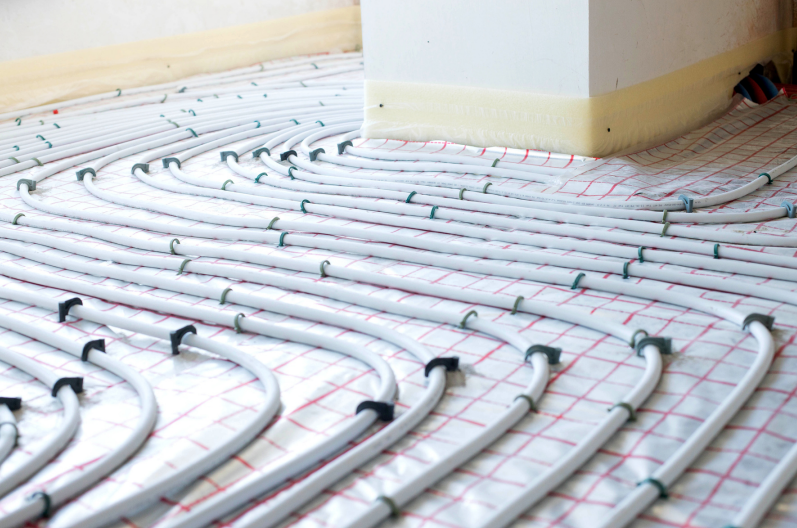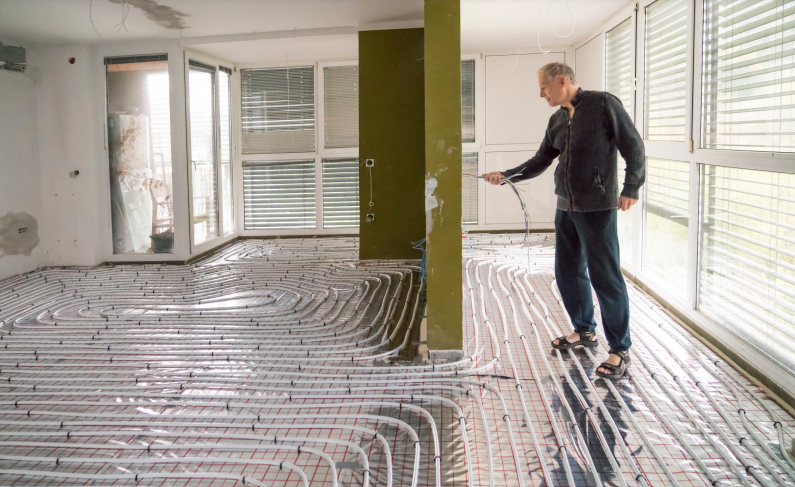Underfloor heating (UFH) is an increasingly popular choice for homeowners looking to enhance the comfort and energy efficiency of their homes. Whether you’re planning an extension or a renovation project, incorporating underfloor heating into your flooring can be a game-changer. It is essential to understand the different UFH systems and how to choose the right flooring materials.
Understanding Underfloor Heating Systems
Before diving into the specifics of flooring, it’s crucial to grasp the fundamentals of underfloor heating systems. These systems typically operate by circulating hot water through a network of pipes or utilise electric heating mats to generate warmth. The primary goal is to heat the solid surface of the floor, which then radiates heat into the room. However, there are a few key points to consider when integrating underfloor heating into your home:

1. Heat Conductivity of Flooring Materials
The choice of flooring material plays a significant role in the efficiency of your underfloor heating system. High-density surfaces like stone or concrete are excellent conductors of heat and radiate warmth effectively. In contrast, low-density materials like cork or carpet are less efficient at conducting and distributing heat. For example, a Tog 2 rated carpet can permit approximately one-third less heat emission than stone or tiles.
2. Surface Material Contact
To maximise energy efficiency, the surface material must either be in direct contact with the underfloor heating system or with the material in which the system is embedded. It’s important to avoid placing insulating underlays beneath flooring materials like timber laminate, as this can hinder heat transfer.
3. Heat Retention
The choice of flooring material also influences how quickly your underfloor heating system heats up and how long it retains heat. For instance, a system embedded within a sand/cement screed may take longer to heat up but will retain warmth for an extended period compared to a system installed in a thin screed beneath timber laminate flooring.
4. Limecrete Compatibility
Underfloor heating can be integrated with limecrete, but precise calculations are necessary to determine the optimal thickness and buildup of floors. Factors such as intended usage, thermal mass properties, underfloor insulation, and anticipated heat load must be considered.
Installation Considerations for Underfloor Heating
When it comes to installing underfloor heating, there are several essential considerations to ensure the system operates efficiently and provides long-term comfort:
1. Acclimatisation of Timber Flooring
If you plan to use timber flooring, it’s crucial to allow sufficient time for it to acclimatise within the building. This process ensures that the timber reaches the temperature and humidity levels it will experience during long-term use, preventing issues like warping or buckling.
2. Proper Drying of Floor Screeds
Before installing most finishes, especially timber and ceramic or vinyl tiles, the floor screeds should be thoroughly dried. Proper drying prevents issues such as adhesion problems and uneven surfaces.
3. Tog Rating of Carpets and Rugs
When selecting carpets and rugs, consider their Tog rating. A Tog rating of 2.0 to 2.5 is typically regarded as the maximum value for underfloor heating. Carpets and rugs with higher Tog ratings may reduce heat transfer efficiency. Additionally, be cautious of polyurethane (PU) foam or acoustic underlays, as they can exacerbate the issue.
4. Heat Output Control
Using floor heat sensors is essential, especially when installing heat-sensitive floor coverings like vinyl and linoleum. These sensors allow you to regulate the heat output and prevent any damage to the flooring material.
5. Decoupling Membrane for Tiles
When laying tiles, consider using a decoupling membrane. This membrane allows for small differences in shrinkage or expansion between the tiles and the floor structure, preventing tile cracking and ensuring a durable finish.

Exploring Flooring Options for Underfloor Heating
Now that we’ve covered the essentials of underfloor heating and installation considerations, let’s delve into the various flooring options that are compatible with underfloor heating systems:
1. Stone
Stone flooring, known for its excellent heat conductivity, is an ideal choice for underfloor heating. It efficiently radiates warmth, creating a cozy and comfortable environment.
2. Ceramics (Tiles)
Ceramic tiles are another superb option for underfloor heating. They not only conduct heat effectively but also come in a wide range of styles, making them a versatile choice for various design preferences.
3. Timber
Timber flooring can work well with underfloor heating, provided it’s properly acclimatised and installed. Timber adds a warm and natural touch to your space.
4. Concrete
Concrete is a highly efficient conductor of heat. Modern self-compacting concrete mixes allow for quick leveling, providing a precise surface for laying floor finishes directly onto it.
5. Composites
Composite flooring materials offer a blend of durability and style. They are compatible with underfloor heating systems and come in various patterns and designs.
6. Bamboo
Bamboo flooring is an eco-friendly choice that works well with underfloor heating. It’s known for its sustainability and unique aesthetic appeal.
7. Carpet
While carpets can be used with underfloor heating, it’s essential to choose those with a Tog rating of 2.0 to 2.5 for optimal heat transfer. Keep in mind that thicker carpets may reduce heating efficiency.
8. Limecrete
Limecrete is a sustainable alternative to traditional concrete. It has lower carbon emissions and can be used in a similar manner, making it a green choice for underfloor heating.
9. Vinyl
Vinyl flooring is resilient and comes in various styles. When using vinyl with underfloor heating, be sure to control the heat output to prevent any damage.
10. Cork
Cork flooring is a unique and eco-friendly option. While it has a lower heat conductivity, it can still work with underfloor heating systems.
11. Clay
Clay tiles are known for their natural and rustic appearance. They can be used with underfloor heating, but careful consideration of heat output is necessary.
12. Resin
Resin flooring offers a seamless and modern look. It can be used in conjunction with underfloor heating for a sleek and contemporary finish.
13. Rubber
Rubber flooring provides excellent insulation and comfort. It can be used with underfloor heating, especially in areas where cushioned flooring is desired.
14. Plywood
Plywood can serve as a subfloor material that works well with underfloor heating. It provides stability and a smooth surface for various finish options.
With such a wide array of flooring materials to choose from, you can select the one that best suits your style preferences, budget, and underfloor heating requirements. Each material has its unique characteristics, so consider your specific needs and the overall design of your space when making your choice.

Green Alternatives: Limecrete and Hempcrete
For those looking to minimise their carbon footprint, consider environmentally friendly alternatives like limecrete and hempcrete. These materials have gained popularity due to their sustainability and compatibility with underfloor heating systems:
Limecrete
Limecrete is a sustainable building material that combines lime with concrete or other aggregates. It offers a lower carbon footprint compared to traditional concrete, making it an eco-conscious choice. When incorporating limecrete into your underfloor heating project, it’s essential to calculate the optimal thickness and build-up of floors based on factors such as intended usage, thermal mass properties, and underfloor insulation.
Limecrete has the advantage of being a breathable material, allowing moisture to pass through it. This characteristic can contribute to a healthier indoor environment by preventing the buildup of moisture and reducing the risk of mold growth. When combined with underfloor heating, limecrete can provide both comfort and sustainability.
Hempcrete or Hemp-Lime
Hempcrete, also known as hemp-lime, is another green alternative to traditional concrete. It is made by mixing the inner fibers of hemp plants with lime and water. This material boasts excellent thermal insulation properties, making it an ideal choice for underfloor heating systems.
Hempcrete is not only lightweight but also has a low environmental impact. It sequesters carbon dioxide during its growth phase, making it a carbon-negative material. When used in flooring applications with underfloor heating, hempcrete can help you create an eco-friendly and energy-efficient living space.
Incorporating underfloor heating into your extension or renovation project can significantly enhance the comfort and energy efficiency of your home. By choosing the right flooring materials and considering essential installation factors, you can enjoy the benefits of a warm and cozy living environment.

From high-conductivity options like stone and ceramics to sustainable choices like limecrete and hempcrete, there’s a flooring material that suits your style and environmental preferences. Before making a decision, assess your specific needs, budget, and design goals to select the most suitable flooring material for your underfloor heating system.
Additionally, keep in mind that proper acclimatization, drying of floor screeds, and the use of appropriate heat control measures are crucial for the efficient operation of your underfloor heating system. Whether you opt for a classic look with timber or a modern finish with resin, underfloor heating can complement your chosen flooring material and elevate your home’s overall ambiance.
As you embark on your journey to create a comfortable and energy-efficient living space, remember that underfloor heating is not just a practical choice but also a sustainable one. By making informed decisions and considering green alternatives like limecrete and hempcrete, you can contribute to a more eco-friendly future while enjoying the warmth and luxury of underfloor heating in your home.




